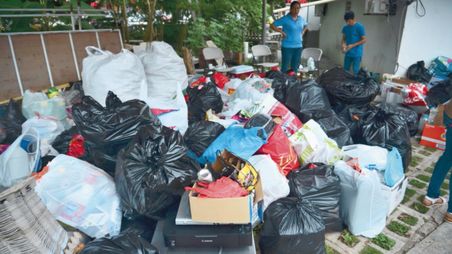Panama awaits Varela signature to Zero Waste bill

PANAMA produces the second largest daily amount of garbage per capita in Latin America and recycles only five percent of it, but a Bill has been passed to change that – when the president gets round to signing it.
Panama City alone generates around 2,500 tons of waste per day and for the whole country is estimated a production of 4, 800 tons a day is collected not counting hospital waste.
Th tonnage according to studies of the Inter-American Development Bank (IDB) and the Pan American Health Organization (PAHO), puts Panama with 1.22 kilos per person per day second only to Chile (1,25 kilos) in Latin America.
Lower are Argentina (1.15), Dominican Republic (1.1), Uruguay (1.03) and Brazil (1).
Our neighbors do even better: Costa Rica (.88 kilos) and Colombia (.62).
Panama’s recycling of less than 5% of garbage is, “small” according to experts as 50% of the daily tonnage is composed of materials that can be recycled: plastic, paper, cardboard, metals, and glass. The rest, is organic waste, reports La Prensa.
Panama City authorities – where the largest amount of garbage is generated agree that it lacks the legislation that addresses waste management in a comprehensive manner.
This led to the bill known as Zero Waste, which was approved in third debate and is awaiting (like many others) the approval of President Varela.
The Zero Waste model is applied in Costa Rica and Colombia.
Zero Waste is a comprehensive policy of waste management that adopts a series of measures in each stage of the materials cycle, from production until they are consumed and discarded.
Waste generators, both residential and commercial and industrial, will have the obligation to separate the waste, according to its type, within the domicile, building or enclosure, to be presented separately for collection.
It will be a 20- year plan with an estimated cost of $ 100 million including a major education campaign of education in schools, universities, entities, NGOs, and neighborhoods.
Estimates from the government indicate that the materials that could be recycled annually in the country would generate $47 million.
The goal of Zero Waste would be to reduce waste volumes per capita by at least 30% by 2035.
Other models of waste management in several countries that have improved recycling rates include charging between $1 and $5 per garbage bag (mixed waste), i0 with no charge for the bags with separated recyclables.
Some 7,000 cities in the United States apply this type of management.
In Taiwan, which went from recycling 5% of its waste to 54% in 14 years. a recycling rate was applied to businesses for the materials they produced and companies were created that gave a second life to papers and plastics. In addition, there were general surcharges on the garbage that each citizen dumped.





